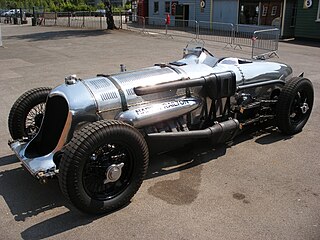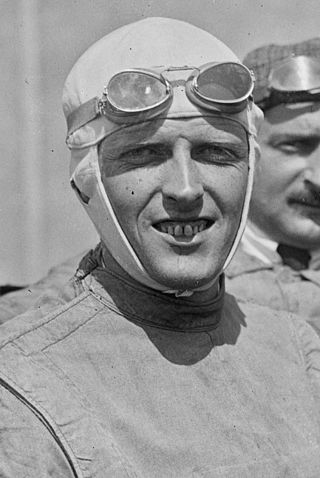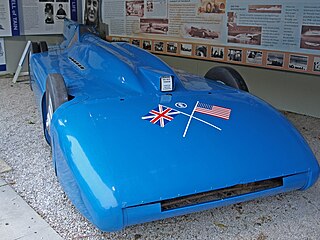
John Rhodes Cobb was an early to mid 20th century English racing motorist. He was three times holder of the World Land Speed Record, in 1938, 1939 and 1947, set at Bonneville Speedway in Utah, US. He was awarded the Segrave Trophy in 1947. He was killed in 1952 whilst piloting a jet powered speedboat attempting to break the World Water Speed Record on Loch Ness water in Scotland.

The Railton Special, later rebuilt as the Railton Mobil Special, is a one-off motor vehicle designed by Reid Railton and built for John Cobb's successful attempts at the land speed record in 1938.

The Napier-Railton is an aero-engined racing car built in 1933, designed by Reid Railton to a commission by John Cobb, and built by Thomson & Taylor. It was driven by Cobb, mainly at the Brooklands race track where it holds the all-time lap record which was set in 1935. The circuit was appropriated for military purposes during the Second World War, and never reopened in that form for racing. It has a W12 engine with 3 different exhaust systems.

The Rolls-Royce R is a British aero engine that was designed and built specifically for air racing purposes by Rolls-Royce Limited. Nineteen R engines were assembled in a limited production run between 1929 and 1931. Developed from the Rolls-Royce Buzzard, it was a 37-litre capacity, supercharged V-12 capable of producing just under 2,800 horsepower (2,090 kW), and weighed 1,640 pounds (770 kg). Intensive factory testing revealed mechanical failures which were remedied by redesigning the components, greatly improving reliability.

The Sunbeam 1000 HP Mystery, or "The Slug", is a land speed record-breaking car built by the Sunbeam car company of Wolverhampton that was powered by two aircraft engines. It was the first car to travel at over 200 mph. The car's last run was a demonstration circuit at Brooklands, running at slow speed on only one engine. It is today on display at the National Motor Museum, Beaulieu.

The Sunbeam 350HP is an aero-engined car built by the Sunbeam company in 1920, the first of several land speed record-breaking cars with aircraft engines.

Sir Henry O'Neal de Hane Segrave was an early British pioneer in land speed and water speed records. Segrave, who set three land and one water record, was the first person to hold both titles simultaneously and the first person to travel at over 200 miles per hour (320 km/h) in a land vehicle. He died in an accident in 1930 shortly after setting a new world water speed record on Windermere in the Lake District, England. The Segrave Trophy was established to commemorate his life.

David Abbott "Ab" Jenkins was the 24th mayor of Salt Lake City, Utah between 1940 and 1944. He was a professional race car driver. Jenkins' interest in motorsports began with racing motorcycles on dirt tracks and across country. He then became interested in land speed records at the Bonneville Salt Flats. He was instrumental in establishing Bonneville as a location for such events, and in attracting overseas drivers such as George Eyston and Sir Malcolm Campbell to compete there.

Ernest Arthur Douglas Eldridge was a British racing driver who broke the world land speed record in 1924. His was the last land speed record set on an open road.

Thunderbolt was a British Land Speed Record holder of the 1930s, driven by Captain George E.T. Eyston.

Captain George Edward Thomas Eyston MC OBE was a British engineer, inventor, and racing driver best known for breaking the land speed record three times between 1937 and 1939.

The Napier-Campbell Blue Bird was a land speed record car driven by Malcolm Campbell. Its designer was C. Amherst Villiers and Campbell's regular mechanic Leo Villa supervised its construction.

The Campbell-Railton Blue Bird was Sir Malcolm Campbell's final land speed record car.
The Sunbeam Tiger is a racing car, built by Sunbeam of Wolverhampton during the 1920s. It was the last car to be competitive both as a land speed record holder, and as a circuit-racing car.

The Sunbeam Silver Bullet was the last attempt at the land speed record by Sunbeam of Wolverhampton. It was built in 1929 for Kaye Don. Powered by two supercharged engines of 24 litres each, it looked impressive but failed to achieve any records.
The Magic Midgets were a number of record-breaking 750cc "midget" MG cars of the 1930s. They were most notably, but not always, driven by George Eyston.

The Mormon Meteor I and III were two land speed record cars built in the 1930s by Ab Jenkins.

An aero-engined car is an automobile powered by an engine designed for aircraft use. Most such cars have been built for racing, and many have attempted to set world land speed records. While the practice of fitting cars with aircraft engines predates World War I by a few years, it was most popular in the interwar period between the world wars when military-surplus aircraft engines were readily available and used to power numerous high-performance racing cars. Initially powered by piston aircraft engines, a number of post-World War II aero-engined cars have been powered by aviation turbine and jet engines instead. Piston-engined, turbine-engined, and jet-engined cars have all set world land speed records. There have also been some non-racing automotive applications for aircraft engines, including production vehicles such as the Tucker 48 and prototypes such as the Chrysler Turbine Car, Fiat Turbina, and General Motors Firebirds. In the late 20th century and into the 21st century, there has also been a revival of interest in piston-powered aero-engined racing cars.
Land speed racing is a form of motorsport.
Flight Lieutenant Christopher Stainbank Staniland was a Royal Air Force pilot, racing driver, and chief test pilot for the Fairey Aviation Company.
The Fabulous Dinky Toys Encyclopaedia.

















